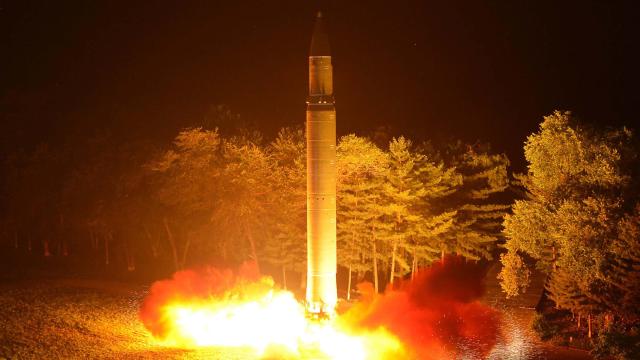Is the US on the brink of all-out nuclear war with North Korea? Experts say no, probably not. But according to a new technical analysis of North Korea’s missile technology in the Bulletin of the Atomic Scientists, even if it did come to that, the closest to the heartland Kim Jong Un can strike is Anchorage, Alaska.
Photo: AP
Massachusetts Institute of Technology missile and nuclear weapons expert Ted Postol, Technical University Munich mechanical and aerospace engineer Markus Schiller and rocketry expert Robert Schmucker all contributed to the report, which argues North Korea’s ballistic missiles have likely been designed to look flashy and trigger an international reaction, not carry a nuclear warhead:
… Calculations we have made — based on detailed study of the type and size of the rocket motors used, the flight times of the stages of the rockets, the propellant likely used, and other technical factors — indicate that these rockets actually carried very small payloads that were nowhere near the weight of a nuclear warhead of the type North Korea could have, or could eventually have. These small payloads allowed the rockets to be lofted to far higher altitudes than they would have if loaded with a much-heavier warhead, creating the impression that North Korea was on the cusp of achieving ICBM capability.
In an interview with Newsweek, Postol called the missiles a “hoax” — presumably one intended to increase North Korea’s bargaining power — but that language does not appear in the report itself
According to the analysis, the Hwasong-14 missiles tested in July were engineered to reach a very high altitude, but may lack the power to carry a heavy nuclear payload across the ocean to the US. If North Korea is using a spherical implosion device modified from a Chinese design obtained by Pakistan and then obtained by Libya, as seems likely, its nuclear warheads likely could not weigh less than 500kg.
While North Korea claims to have a 400kg nuclear bomb, the researchers wrote, a functioning ICBM would need to include other heavy components including a heat shield and “the structure needed to hold an atomic bomb in place during deceleration.” Even a conservative estimate of the weight of the other components of the warhead assembly places North Korea’s nuclear warheads at a minimum of 500-600kg.
“Our estimates show that the Hwasong-14, using the publicly reported burn times for the upper rocket stage, could deliver a nuclear warhead only as far as Anchorage, Alaska if the warhead weighed 500kg to 550kg,” the researchers wrote. “To reach Seattle, the warhead would have to be substantially smaller, weighing no more than 300 kilos.”
If North Korea installed a more advanced vernier thruster to the rocket’s upper stage, they added, it could potentially deliver a much heavier payload to Alaska but striking Seattle would still require the bomb weigh no more than 400-450kg.
According to the researchers, large amounts of photo, video and telemetry data as well as their own knowledge of rocket systems indicate North Korea lacks the capability to manufacture its own advanced missile components and is still repurposing Soviet-era parts. This is where the good news ends, they wrote: “Their skill and ingenuity in using Soviet rocket motor components has grown very substantially. This is not good news for the long run.”
As Newsweek noted, prior reports anonymously sourced to the Defence Intelligence Agency suggested North Korea has successfully miniaturised atomic bombs and possesses missiles capable of lobbing them into the US, and perhaps has 30 to 60 of them. The new report puts some doubt on those conclusions, indicating North Korea is still “probably years away” from that level of technical ability.
A more limited assessment of North Korea’s nuclear capabilities might be one of several reasons why, as Donald Trump has spent the past week making reassured the public there is no reason to panic.
While the report might help a few people sleep a little better at night, there are still many ways this situation could go FUBAR short of a North Korean strike on the US mainland. There is little doubt the country has the capability to at least attempt strikes on regional allies like South Korea and Japan, or the US territory of Guam.
And even a limited nuclear engagement could kill millions by itself, or trigger a larger nuclear exchange which could kill many millions more. Maybe only time will tell if all the people buying bomb shelters these days are making a good investment.
